Charles E W Bean, Diaries, AWM38 3DRL 606/248/1 - 1917 - 1931 - Part 3
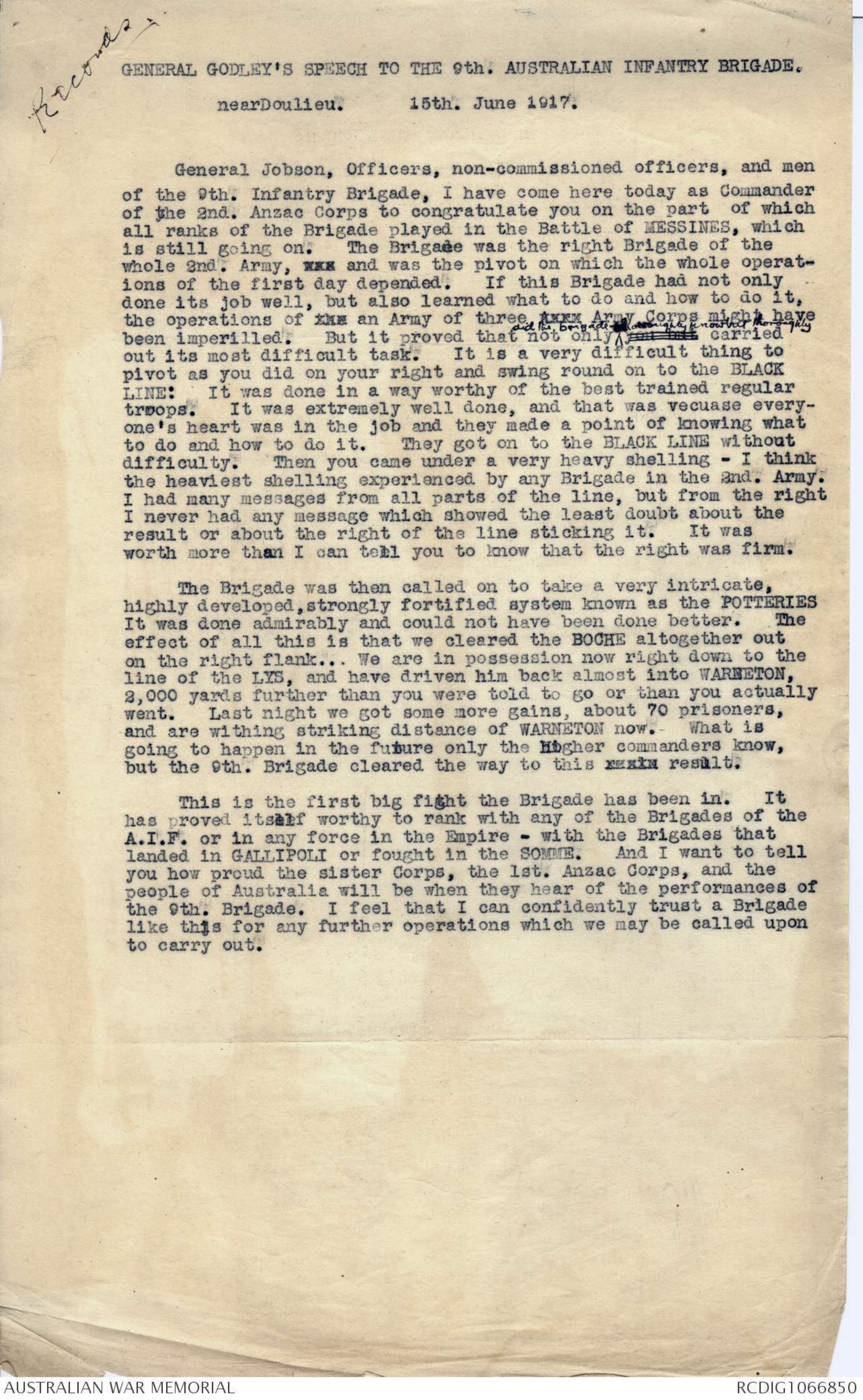
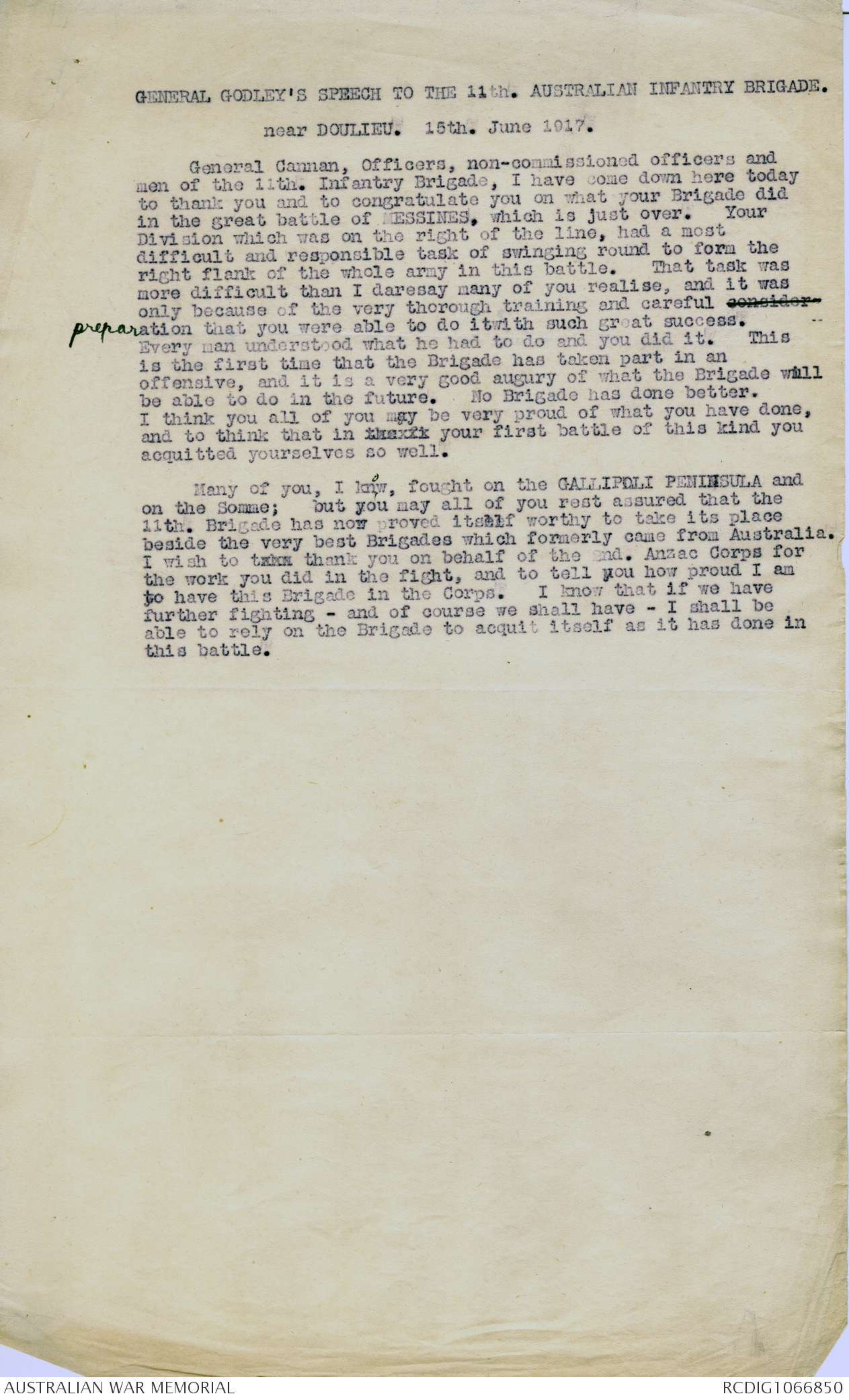
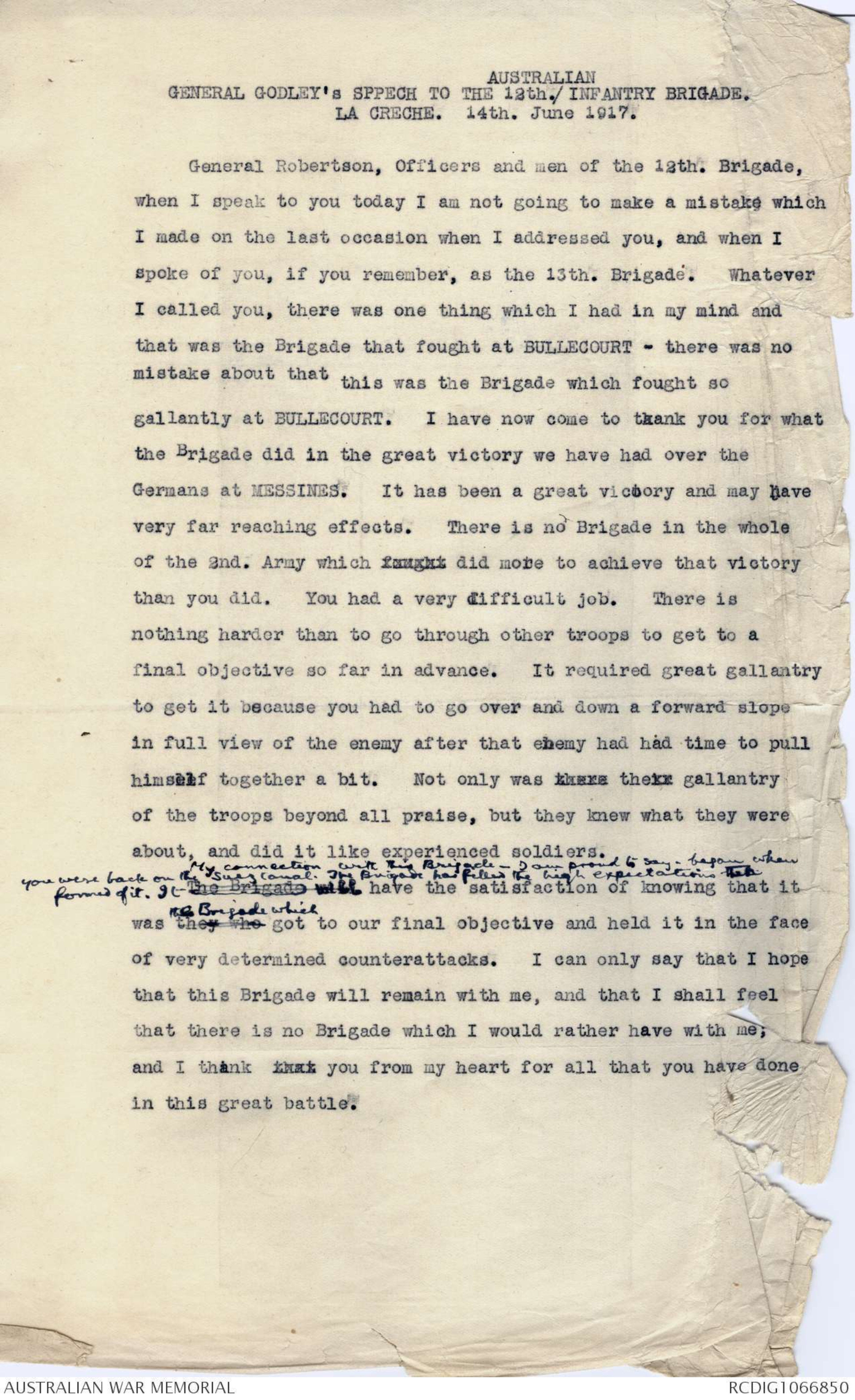
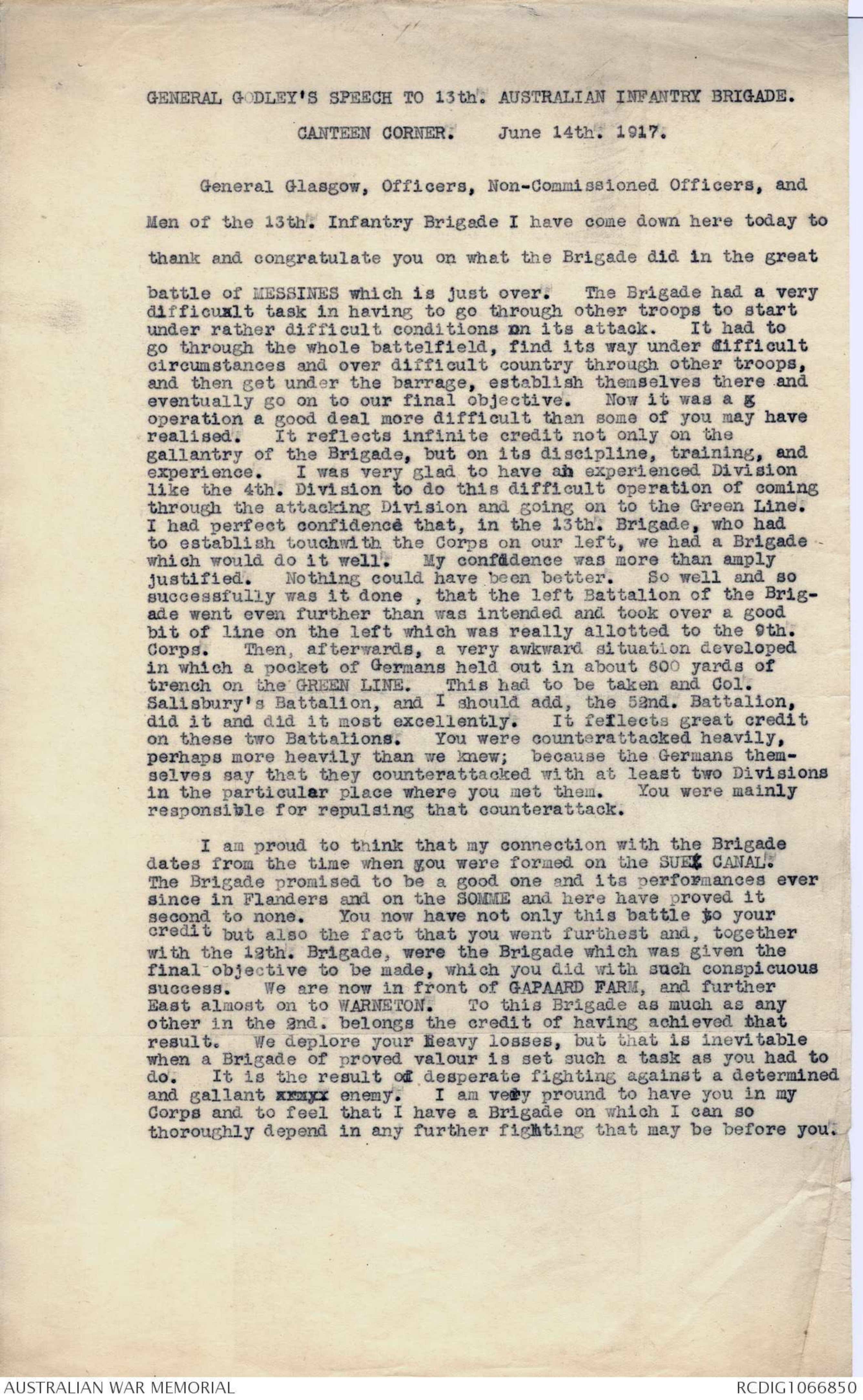
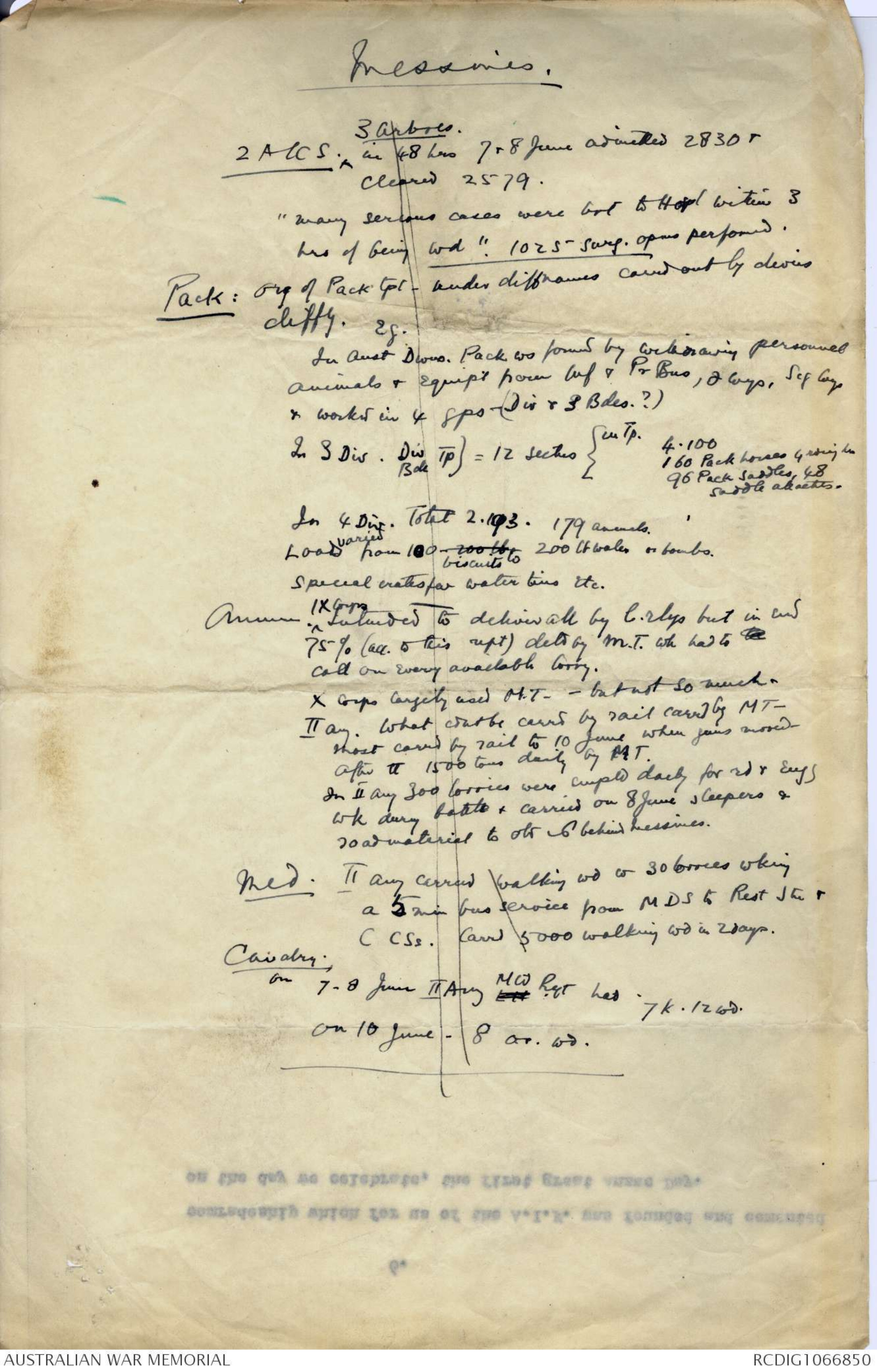
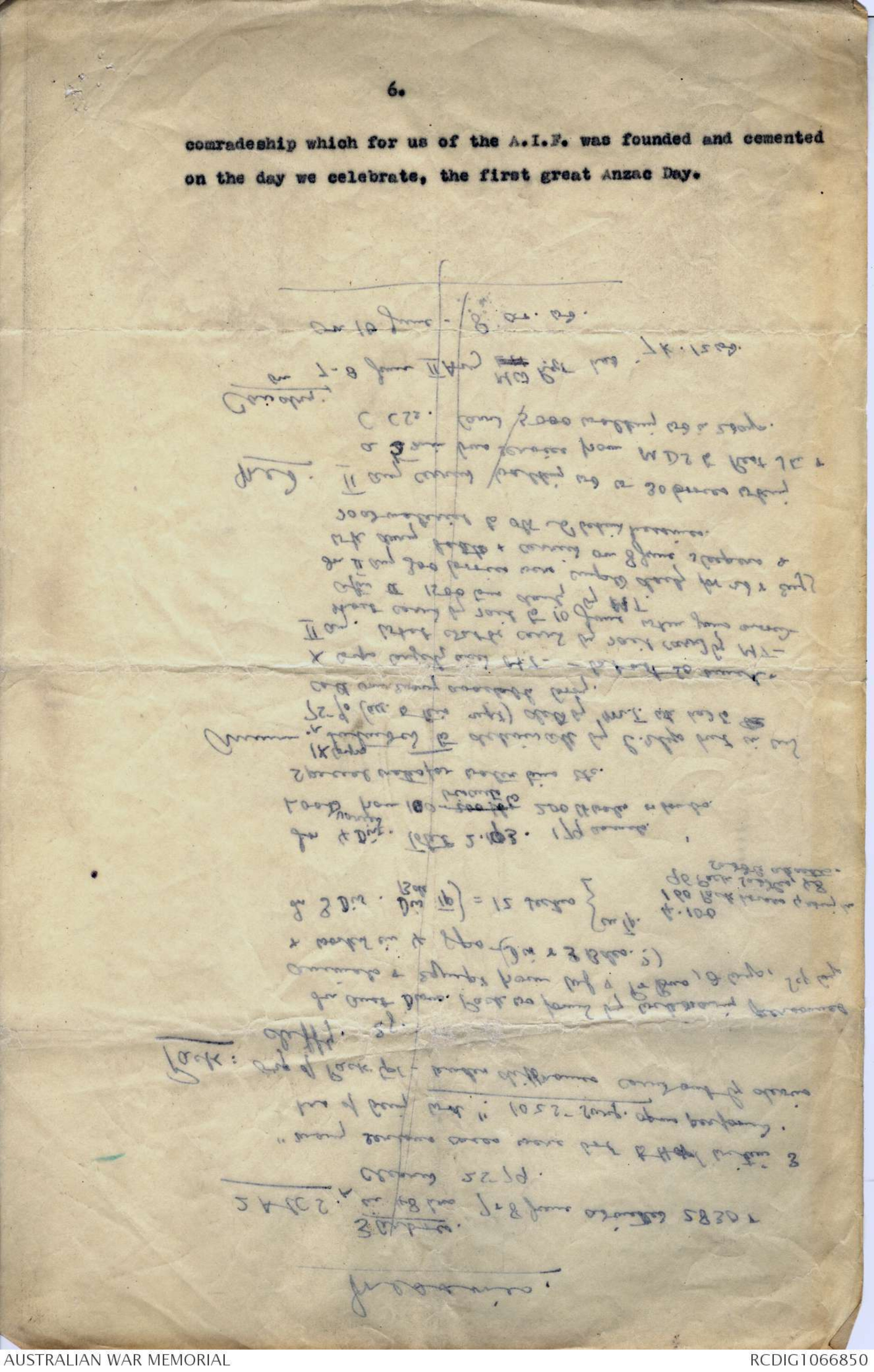
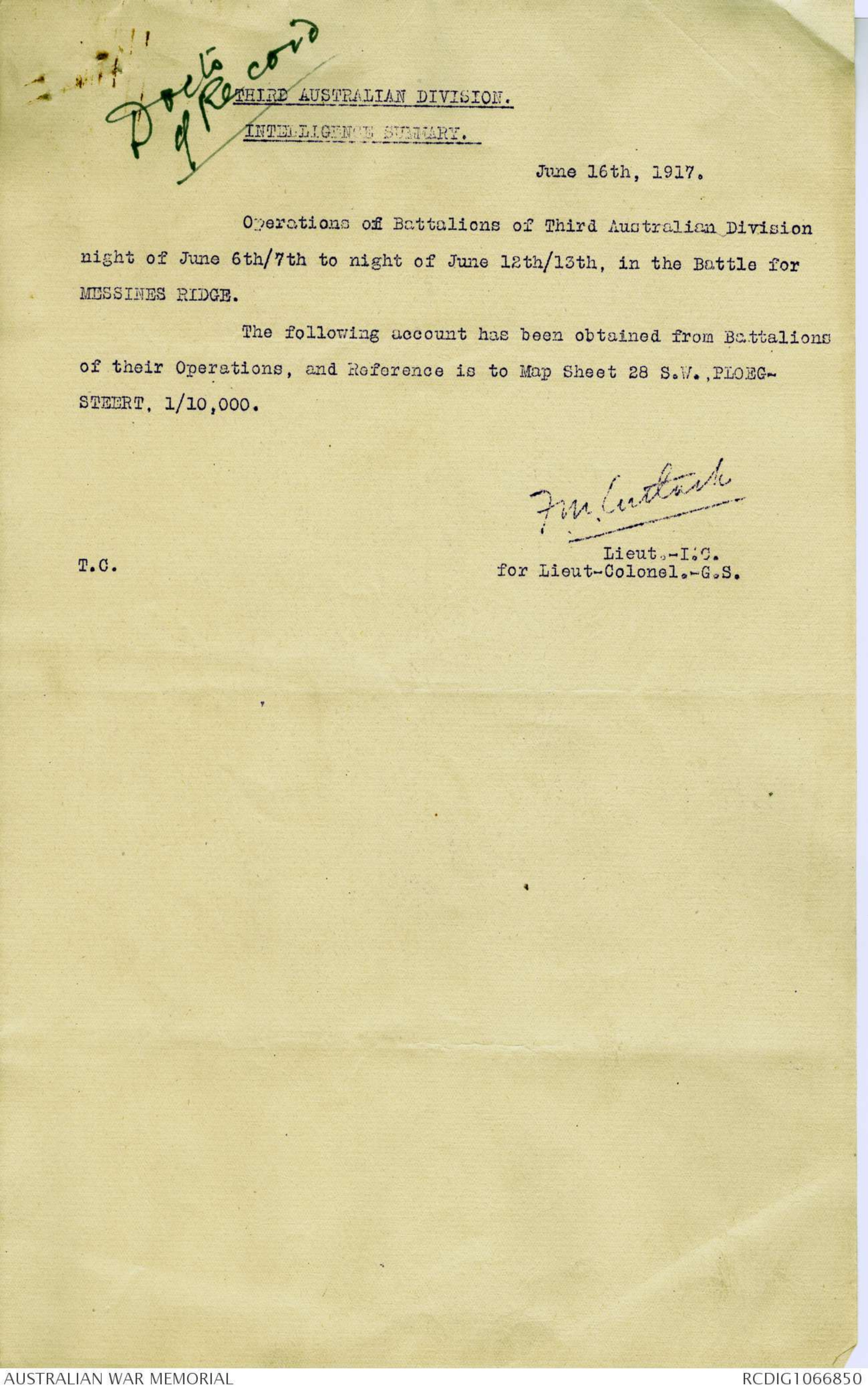
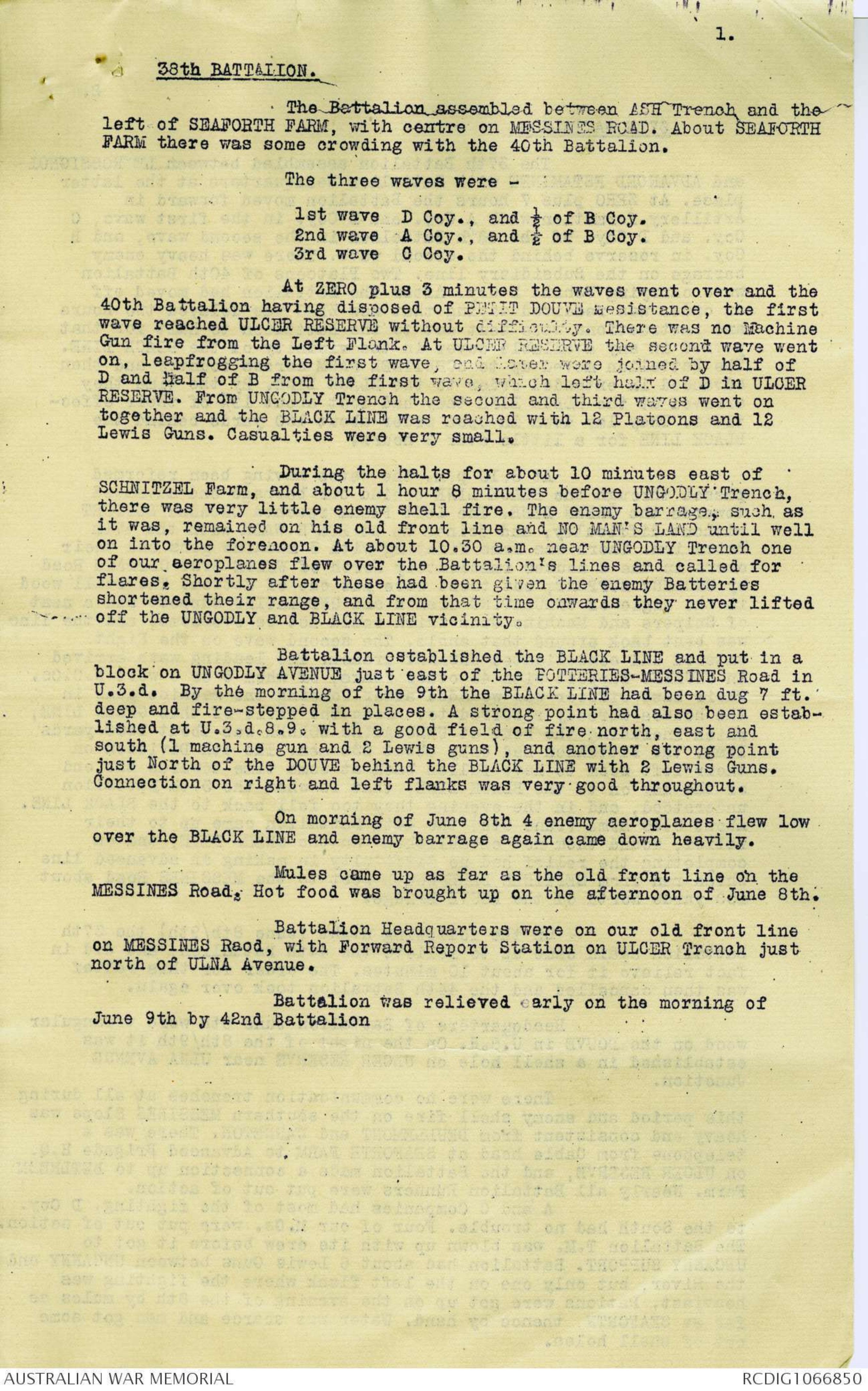
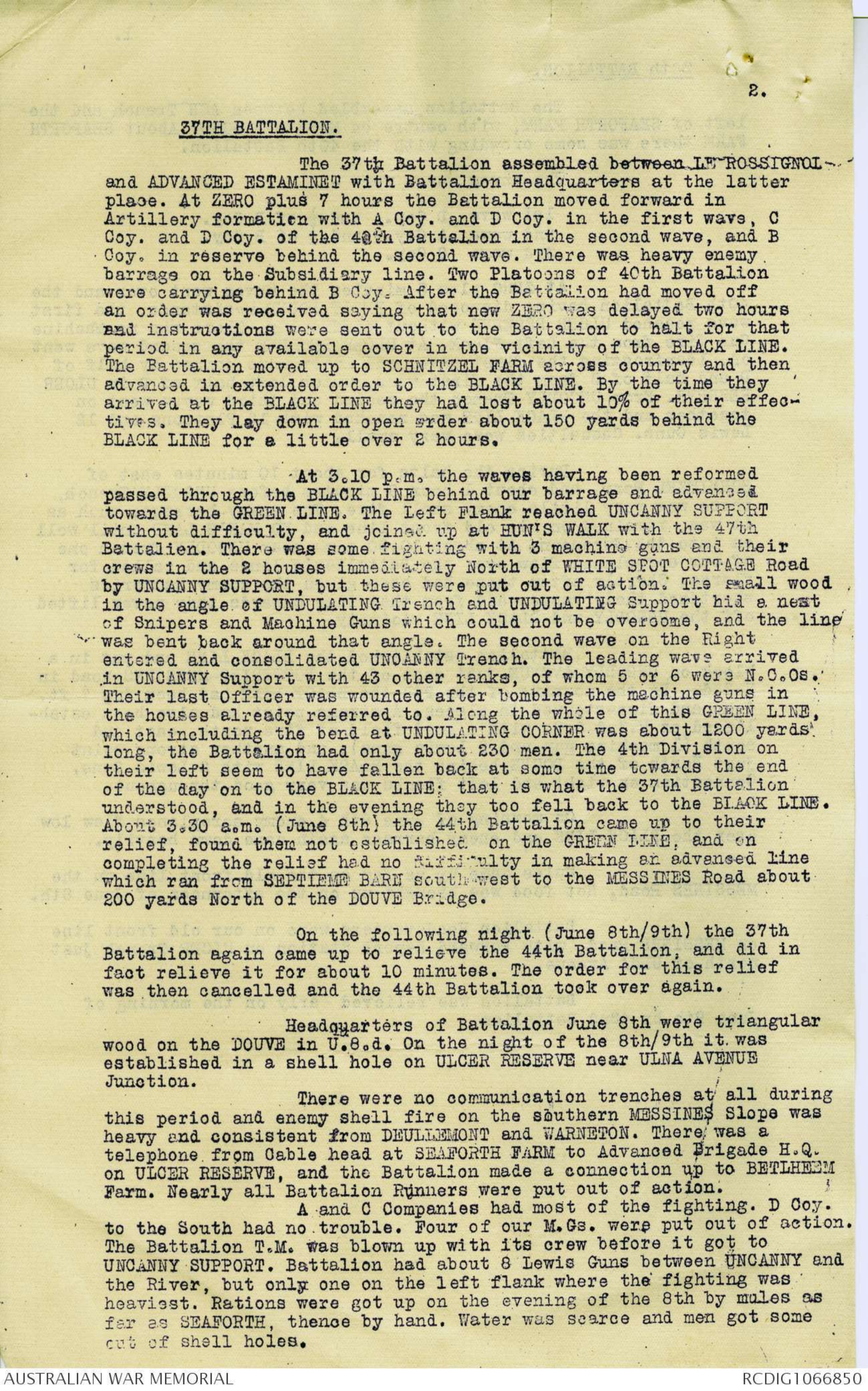
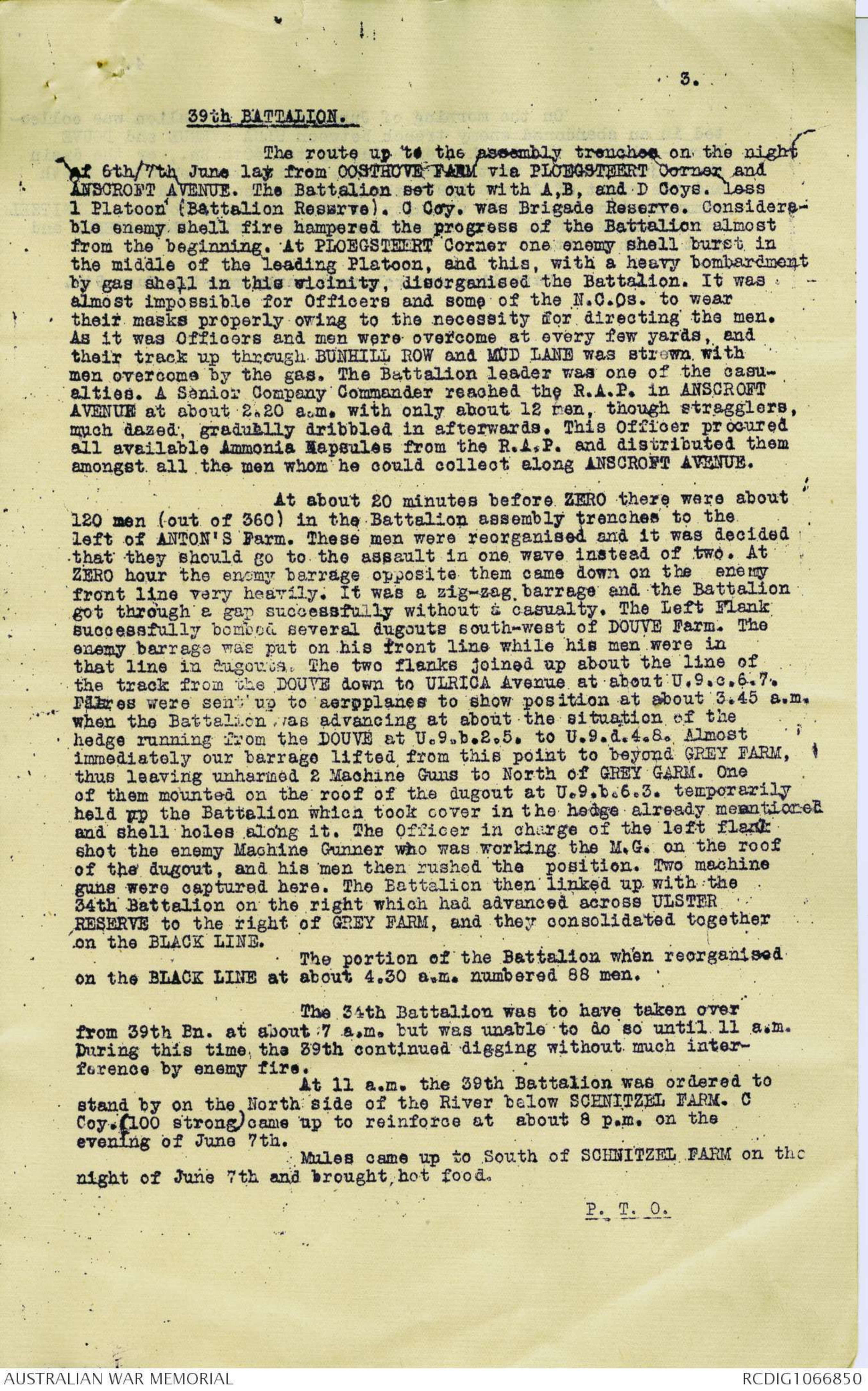
Records
GENERAL GODLEY'S SPEECH TO THE 9th. AUSTRALIAN INFANTRY BRIGADE.
nearDoulieu. 5th. June 1917.
General Jobson, Officers, non-commissioned officers, and men
of the 9th. Infantry Brigade, I have come here today as Commander
of the 2nd. Anzac Corps to congratulate you on the part of which
all ranks of the Brigade played in the Battle of MESSINES, which
is still going on. The Brigade was the right Brigade of the
whole 2nd. Army, xxx and was the pivot on which the whole operations
of the first day depended. If this Brigade had not only
done its job well, but also learned what to do and how to do it,
the operations of the an Army of three xxxx Amy Corps might have
been imperilled. But it proved that not only did the Brigade thoroughly know but thoroughly you but carried
out its most difficult task. It is a very difficult thing to
pivot as you did on your right and swing round on to the BLACK
LINE: It was done in a way worthy of the best trained regular
troops. It was extremely well done, and that was vecuase everyone's
heart was in the job and they made a point of knowing what
to do and how to do it. They got on to the BLACK LINE without
difficulty. Then you came under a very heavy shelling - I think
the heaviest shelling experienced by any Brigade in the 2nd: Army.
I had many messages from all parts of the line, but from the right
I never had any message which showed the least doubt about the
result or about the right of the line sticking it. It was
worth more than I can tell you to know that the right was firm.
The Brigade was then called on to take a very intricate
highly developed,strongly fortified system known as the POTTERIES
It was done admirably and could not have been done better. The
effect of all this is that we cleared the BOCHE altogether out
on the right flank... We are in possession now right down to the
line of the LYS, and have driven him back almost into WARNETON,
2,000 yards further than you were told to go or than you actually
went. Last night we got some more gains, about 70 prisoners,
and are withing striking distance of WARNETON now. What is
going to happen in the future only the Higher commanders know,
but the 9th. Brigade cleared the way to this xxxx result:
This is the first big fight the Brigade has been in. It
has proved itself worthy to rank with any of the Brigades of the
A.I.F. or in any force in the Empire - with the Brigades that
landed in GALLIPOLI or fought in the SOMME. And I want to tell
you how proud the sister Corps, the 1st. Anzac Corps, and the
people of Australia will be when they hear of the performances of
the 9th. Brigade. I feel that I can confidently trust a Brigade
like this for any further operations which we may be called upon
to carry out.
GENERAL GODLEY'S SPEECH TO THE 11th. AUSTRALIAN INFANTRY BRIGADE.
near DOULIEU. 15th. June 1917.
General Cannan, Officers, non-commissioned officers and
men of the 11th. Infantry Brigade, I have come down here today
to thank you and to congratulate you on what your Brigade did
in the great battle of MESSINES, which is just over. Your
Division which was on the right of the line, had a most
difficult and responsible task of swinging round to form the
right flank of the whole army in this battle. That task was
more difficult than I daresay many of you realise, and it was
only because of the very thorough training and careful consider
preparation that you were able to do itwith such great success.
Every man understood what he had to do and you did it. This
is the first time that the Brigade has taken part in an
offensive, and it is a very good augury of what the Brigade will
be able to do in the future. No Brigade has done better.
I think you all of you may be very proud of what you have done,
and to think that in your first battle of this kind you
acquitted yourselves so well.
Many of you, I know, fought on the GALLIPOLI PENINSULA and
on the Somme; but you may all of you rest assured that the
11th. Brigade has now proved itself worthy to take its place
beside the very best Brigades which formerly came from Australia.
I wish to xxxx thank you on behalf of the 2nd. Anzac Corps for
the work you did in the fight, and to tell you how proud I am
to have this Brigade in the Corps. I know that if we have
further fighting - and of course we shall have - I shall be
able to rely on the Brigade to acquit itself as it has done in
this battle.
GENERAL GODLEY's SPPECH TO THE 19th. AUSTRALIAN INFANTRY BRIGADE.
LA CRECHE. 14th. June 1917.
General Robertson, Officers and men of the 12th. Brigade,
when I speak to you today I am not going to make a mistake which
I made on the last occasion when I addressed you, and when I
spoke of you, if you remember, as the 13th. Brigadé: Whatever
I called you, there was one thing which I had in my mind and
that was the Brigade that fought at BULLECOURT - there was no
mistake about that this was the Brigade which fought so
gallantly at BULLECOURT. I have now come to thank you for what
the Brigade did in the great victory we have had over the
Germans at MESSINES. It has been a great victory and may have
very far reaching effects. There is no Brigade in the whole
of the 2nd. Army which fought did more to achieve that victory
than you did. You had a very difficult job. There is
nothing harder than to go through other troops to get to a
final objective so far in advance. It required great gallantry
to get it because you had to go over and down a forward slope
in full view of the enemy after that enemy had had time to pull
himself together a bit. Not only was there their gallantry
of the troops beyond all praise, but they knew what they were
about, and did it like experienced soldiers.
My connection with the Brigade - I am proud to say began when
you were back on the Suez Canal. The Brigade has filled the high expectations that
formed it. It will have the satisfaction of knowing that it
was the Brigade which got to our final objective and held it in the face
of very determined counterattacks. I can only say that I hope
that this Brigade will remain with me, and that I shall feel
that there is no Brigade which I would rather have with me,
and I thank xxxx you from my heart for all that you have done.
in this great battle.
GENERAL GODLEY'S SPEECH TO 13th. AUSTRALIAN INFANTRY BRIGADE.
CANTEEN CORNER. June 14th. 1917.
General Glasgow, Officers, Non-Commissioned Officers, and
Men of the 13th. Infantry Brigade I have come down here today to
thank and congratulate you on what the Brigade did in the great
battle of MESSINES which is just over. The Brigade had a very
difficualt task in having to go through other troops to start
under rather difficult conditions on its attack. It had to
go through the whole battelfield, find its way under difficult
circumstances and over difficult country through other troops,
and then get under the barrage, establish themselves there and
eventually go on to our final objective. Now it was a g
operation a good deal more difficult than some of you may have
realised. It reflects infinite credit not only on the
gallantry of the Brigade, but on its discipline, training, and
experience. I was very glad to have an experienced Division
like the 4th. Division to do this difficult operation of coming
through the attacking Division and going on to the Green Line:
I had perfect confidence that, in the 13th. Brigade, who had
to establish touchwith the Corps on our left, we had a Brigade
which would do it well. My confidence was more than amply
justified. Nothing could have, been better. So well and so
successfully was it done, that the left Battalion of the Brigade
went even further than was intended and took over a good
bit of line on the left which was really allotted to the 9th.
Corps. Then, afterwards, a very awkward situation developed
in which a pocket of Germans held out in about 600 yards of
trench on the GREEN LINE. This had to be taken and Col.
Salisbury's Battalion, and I should add, the 52nd. Battalion,
did it and did it most excellently. It reflects great credit
on these two Battalions. You were counterattacked heavily,
perhaps more heavily than we knew; because the Germans themselves
say that they counterattacked with at least two Divisions
in the particular place where you met them. You were mainly
responsible for repulsing that counterattack.
I am proud to think that my connection with the Brigade
dates from the time when you were formed on the SUEZX CANAL.
The Brigade promised to be a good one and its performances ever
since in Flanders and on the SOMME and here have proved it
second to none. You now have not only this battle to your
credit but also the fact that you went furthest and, together
with the 12th. Brigade, were the Brigade which was given the
final objective to be made, which you did with such conspicuous
success. We are now in front of GAPAARD FARM, and further
East almost on to WARNETON. To this Brigade as much as any
other in the 2nd. belongs the credit of having achieved that
result. We deplore your Heavy losses, but that is inevitable
when a Brigade of proved valour is set such a task as you had to
do. It is the result of desperate fighting against a determined
and gallant xxxxx enemy. I am very proud to have you in my
Corps and to feel that I have a Brigade on which I can so
thoroughly depend in any further fighting that may be before you:
Messines.
2 AlCS. 3Arbres. in 48 hrs 7&8 June admitted 3830 &
cleared 2579.
"many serious cases were brt to Hospl within 3
hrs of being wd" 1025 surg. opns performed.
Pack: Org of Pack tpl - under diffnawes carriedout by devies
cleffy
28.
In Aust Divs, Pack ws formed by wil[[?]]awing personnel
animals & equipt from wf & Pr Bus, 2 Coys Coys, Sep Coys
& works in 4 gps -(Div & 3 Bdes.?)
| In 5 Div | . |
Div Bde |
| Tp} | |
= 12 Sectns |
{wTp. | |
|
4.100 160 Pack horses 96 Pack saddles, 48 saddle abactes. |
In 4 Div. Total 2.193. 179 animals
Load varied from 100-200lb biscuits to 200 lt water or bombs
Special crates for water tins etc.
Ammn 1X Corps intended to deliver all by C.rlys but in [[?]]S
75% (acc. to this rept) dels by M.T. wh had to
call on every available lorry.
X Corps largely used M.T. - but not so much.
II ay. What ctnt be carrd by rail carried by MT-
most carried by rail to 10 June when [[?]] moved
after ii 1500 tons daily by MT.
In II ary 300 lorries were suppld daily for [[?]] & [[?]]
wk during battle & carried on 8 June ceepers &
20 ad material to old S behind Messines.
Med. II ary carried walking wd to 30 lorries wking
a 5 min bus service from MDS to Rest J [[?]] &
C CSs. Carried 5000 walking wd in 2 days.
Cavalry.
on 7-8 June II Ary MW Rgt has . 7k . 12wd.
on 10 June - 8 o.r. wd.
______________________
6.
comradeship which for us of the A.I.F. was founded and cemented
on the day we celebrate, the first great Anzac Day.
Docts of Record
THIRD AUSTRALIAN DIVISION.
INTELLIGENCE SUMMARY.
June 16th, 1917.
Operations of Battalions of Third Australian Division
night of June 6th/7th to night of June 12th/13th, in the Battle for
MESSINES RIDGE.
The following account has been obtained from Battalions
of their Operations, and Reference is to Map Sheet 28 S.W., PLOEGSTEERT,
1/10,000.
F.M.Cutlack
Lieut.-I.C.
for Lieut-Colonel.-G.S.
T.C.
1.
38th BATTALION.
The Battalion assembled between ASH Trench and the
left of SEAFORTH FARM, with centre on MESSINES ROAD. About SEAFORTH
FARM there was some crowding with the 40th Battalion.
The three waves were -
1st wave D Coy., and ½ of B Coy.
2nd wave A Coy., and ½ of B Coy.
3rd wave C Coy.
At ZER0 plus 3 minutes the waves went over and the
40th Battalion having disposed of PETIT DOUVE resistance, the first
wave reached ULCER RESERVE without difficulty. There was no Machine
Gun fire from the Left Flank. At ULCER RESERVE the second wave went
on, leapfrogging the first wave, and layer were joined by half of
D and Half of B from the first wave, which left half of D in ULCER
RESERVE. From UNCODLY Trench the second and third waves went on
together and the BLACK LINE was reached with 12 Platoons and 12
Lewis Guns. Casualties were very small.
During the halts for about 10 minutes east of
SCHNITZEL Farm, and about 1 hour 8 minutes before UNGODLY Trench,
there was very little enemy shell fire. The enemy barrage, such as
it was, remained on his old front line and NO MAN'S LAND until well
on into the forenoon. At about 10.30 a.m. near UNGODLY Trench one
of our aeroplanes flew over the Battalion's lines and called for
flares. Shortly after these had been given the enemy Batteries
shortened their range, and from that time onwards they never lifted
off the UNGODLY and BLACK LINE vicinity.
Battalion established the BLACK LINE and put in a
block on UNGODLY AVENUE just east of the POTTERIES-MESSINES Road in
U.3.d. By the morning of the 9th the BLACK LINE had been dug 7 ft.
deep and fire-stepped in places. A strong point had also been established
at U.3.d.8.9. with a good field of fire north, east and
south (1 machine gun and 2 Lewis guns), and another strong point
just North of the DOUVE behind the BLACK LINE with 2 Lewis Guns.
Connection on right and left flanks was very good throughout.
On morning of June 8th 4 enemy aeroplanes flew low
over the BLACK LINE and enemy barrage again came down heavily.
Mules came up as far as the old front line on the
MESSINES Road. Hot food was brought up on the afternoon of June 8th.
Battalion Headquarters were on our old front line
on MESSINES Road, with Forward Report Station on ULCER Trench just
north of ULNA Avenue.
Battalion was relieved early on the morning of
June 9th by 42nd Battalion
2.
37TH BATTALION.
The 37th Battalion assembled between LE ROSSIGNOL-
and ADVANCED ESTAMINET with Battalion Headquarters at the latter
place. At ZERO plus 7 hours the Battalion moved forward in
Artillery formation with A Coy, and D Coy. in the first wavs C
Coy, and D Coy, of the 40h Battalion in the second wave, and B
Coy. in reserve behind the second wave. There was heavy enemy
barrage on the Subsidiary line. Two Platoons of 40th Battalion
were carrying behind B Coy. After the Battalion had moved off
an order was received saying that new ZERO was delayed two hours
and instructions were sent out to the Battalion to halt for that
period in any available cover in the vicinity of the BLACK LINE.
The Battalion moved up to SCHNITZEL FARM across country and then
advanced in extended order to the BLACK LINE. By the time they
arrived at the BLACK LINE they had lost about 10% of their effectives.
They lay down in open order about 150 yards behind the
BLACK LINE for a little over 2 hours.
At 3.10 p.m, the waves having been reformed
passed through the BLACK LINE behind our barrage and advanced
towards the GREEN LINE. The Left Flank reached UNCANNY SUPPORT
without difficulty, and joined up at HUN'S WALK with the 47th
Battalion. There was some fighting with 3 machine guns and their
crews in the 2 houses immediately North of WHITE SPOT COTTAGE Road
by UNGANNY SUPPORT, but these were put out of action. The small wood
in the angle of UNDULATING Trench and UNDULATIIG Support hid a nest
of Snipers and Machine Guns which could not be overoome, and the line
was bent back around that angle. The second wave on the Right
entered and consolidated UNCANNY Trench. The leading wave arrived
in UNCANNY Support with 43 other ranks, of whom 5 or 6 were N.C.Os.
Their last Officer was wounded after bombing the machine guns in
the houses already referred to. Along the whole of this GREEN LINE.
which including the bend at UNDULATING CORNER was about 1200 yards:
long, the Battalion had only about 230 men. The 4th Division on
their left seem to have fallen back at somo time towards the end
of the day on to the BLACK LINE; that is what the 37th Battalion
understood, and in the evening they too fell back to the BLAOK LINE.
About 3.30 a.m. (June 8th) the 44th Battalion came up to their
relief, found them not established on the GREHN LINE, and on
completing the relief had no difficulty in making an advanced line
which ran from SEPTIEME BARN scoth west to the MESSINES Road about
200 yards North of the DOUVE Bridge.
On the following night (June 8th/9th) the 37th
Battalion again came up to relieve the 44th Battalion, and did in
fact relieve it for about 10 minutes. The order for this relief
was then cancelled and the 44th Battalion took over again.
Headquarters of Battalion June 8th were triangular
wood on the DOUVE in U.8.d. On the night of the 8th/9th it was
established in a shell hole on ULCER RESERVE near ULNA AVENUE
Junction.
There were no communication trenches at all during
this period and enemy shell fire on the southern MESSINES Slope was
heavy and consistent from DEULLEMONT and WARNETON. There was a
telephone from Cable head at SEAFORTH FARM to Advanced Brigade H.Q.
on ULCER RESERVE, and the Battalion made a connection up to BETLHEEM
Farm. Nearly all Battalion Runners were put out of action.
A and C Companies had most of the fighting. D Coy.
to the South had no trouble. Four of our M.Gs. were put out of action.
The Battalion T.M. was blown up with its crew before it got to
UNCANNY SUPPORT. Battalion had about 8 Lewis Guns between UNCANNY and
the River, but only one on the left flank where the fighting was
heaviest. Rations were got up on the evening of the 8th by mules as
ar as SEAFORTH, thence by hand. Water was scarce and men got some
out of shell holes.
3.
39th BATTALION.
The route up to the assembly trenches on the night
of 6th/7th June lay from OOSTHOVE FARM via PLOEGSTEERT Corner and
ANSCROFT AVENUE. The Battalion set out with A,B, and D Coys. Less
1 Platoon (Battalion Reserve). C Coy, was Brigade Reserve. Considerable
enemy shell fire hampered the progress of the Battalion almost
from the beginning. At PLOEGSTEERT Corner one enemy shell burst in
the middle of the leading Platoon, and this, with a heavy bombardment
by gas shell in this vicinity, disorganised the Battalion. It was
almost impossible for Officers and somo of the N.C.Os. to wear
their masks properly owing to the necessity for directing the men.
As it was Officers and men were overcome at every few yards, and
their track up threugh BUNHILL ROW and MUD LANE was strewn with
men overcome by the gas. The Battalion leader was one of the casualties.
A Senior Company Commander reached the R.A.P. in ANSCROFT
AVENUE at about 2.20 a.m. with only about 12 men, though stragglers
much dazed, gradually dribbled in afterwards. This Officer procured
all available Ammonia [[?]]apsules from the R.A.P. and distributed them
amongst all the men whom he could collect along ANSCROFT AVENUE.
At about 20 minutes before ZER0 there were about
120 men (out of 360) in the Battalion assembly trenches to the
left of ANTON'S Farm. These men were reorganised and it was decided
that they should go to the assault in one wave instead of two. At
ZERO hour the enemy barrage opposite them came down on the enemy
front line very heavily. It was a zig-zag barrage and the Battalion
got through a gap successfully without a casualty. The Left Flank
successfully bombed several dugouts south-west of DOUVE Farm. The
enemy barrage was put on his front line while his men were in
that line in dugouts. The two flanks joined up about the line of
the track from the DOUVE down to ULRICA Avenue at about U.9.c.6.7.
Flares were sent up to aeroplanes to show position at about 3.45 a.m.
when the Battalion as advancing at about the situation of the
hedge running Trom the DOUVE at U.9.b.2.5. to U.9.d.4.8. Almost
immediately our barrago lifted from this point to beyond GREY FARM,
thus leaving unharmed 2 Machine Guns to North of GREY GARM. One
of them mounted on the roof of the dugout at U.9.b.6.3. temporarily
held up the Battalion which took cover in the hedge already meantioned
and shell holes along it. The Officer in charge of the left flank
shot the enemy Machine Gunner who was working the M.G. on the roof
of the dugout, and his men then rushed the position. Two machine
guns were captured here. The Battalion then linked up with the
34th Battalion on the right which had advanced across ULSTER
RESERVE to the right of GREY FARM, and they consolidated together
on the BLACK LINE.
The portion of the Battalion when reorganised
on the BLACK LINE at about 4.30 a.m. numbered 88 men.
The 34th Battalion was to have taken over
from 39th Bn. at about 7 a.m. but was unable to do so until 11 a.m.
During this time, the 39th continued digging without much interference
by enemy fire.
At 11 a.m. the 39th Battalion was ordered to
stand by on the North side of the River below SCHNITZEL FARM. C
Coy.(100 strong)came up to reinforce at about 8 p.m. on the
evening of June 7th.
Mules came up to South of SCHNITZEL FARM on the
night of June 7th and brought, hot food.
P.T. 0.
 Sandy Mudie
Sandy MudieThis transcription item is now locked to you for editing. To release the lock either Save your changes or Cancel.
This lock will be automatically released after 60 minutes of inactivity.